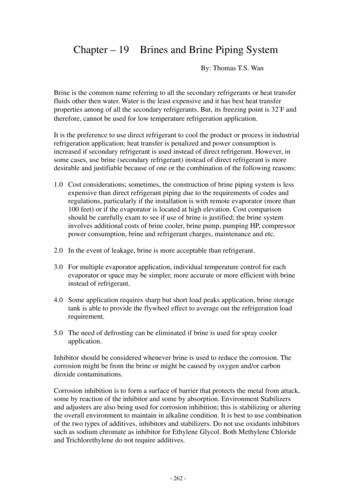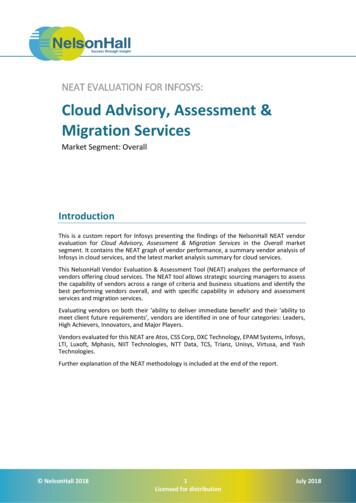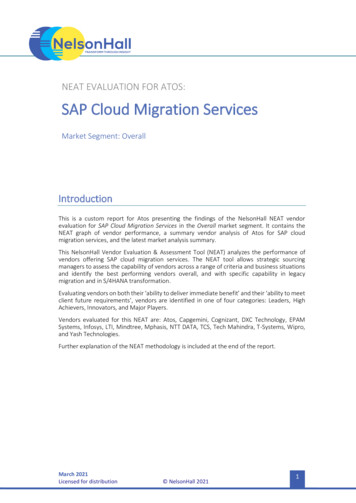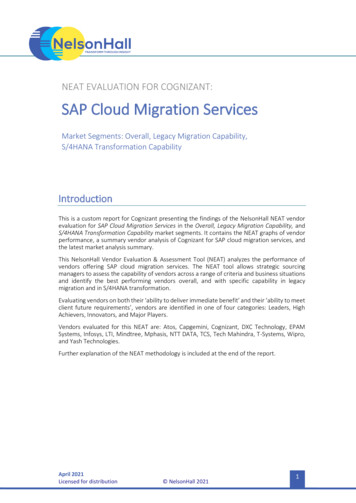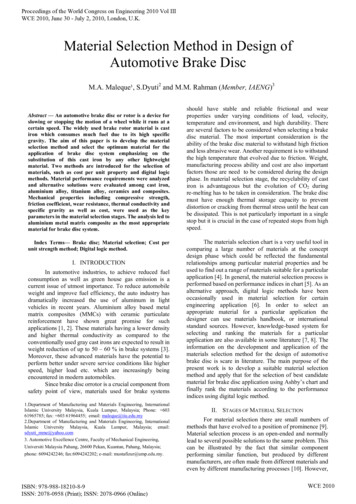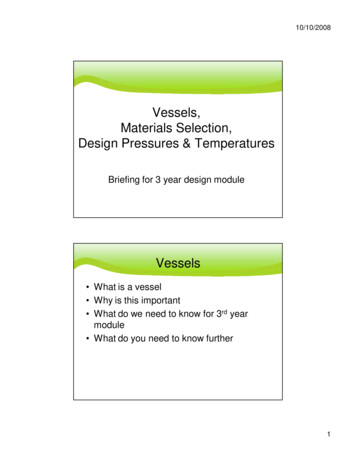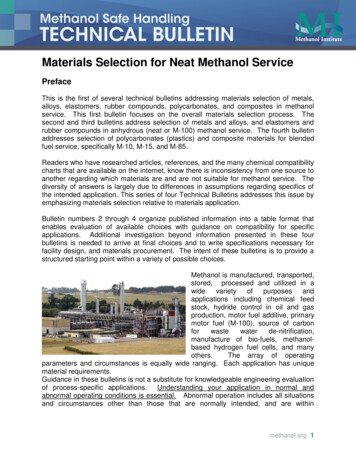
Transcription
Materials Selection for Neat Methanol ServicePrefaceThis is the first of several technical bulletins addressing materials selection of metals,alloys, elastomers, rubber compounds, polycarbonates, and composites in methanolservice. This first bulletin focuses on the overall materials selection process. Thesecond and third bulletins address selection of metals and alloys, and elastomers andrubber compounds in anhydrous (neat or M-100) methanol service. The fourth bulletinaddresses selection of polycarbonates (plastics) and composite materials for blendedfuel service, specifically M-10, M-15, and M-85.Readers who have researched articles, references, and the many chemical compatibilitycharts that are available on the internet, know there is inconsistency from one source toanother regarding which materials are and are not suitable for methanol service. Thediversity of answers is largely due to differences in assumptions regarding specifics ofthe intended application. This series of four Technical Bulletins addresses this issue byemphasizing materials selection relative to materials application.Bulletin numbers 2 through 4 organize published information into a table format thatenables evaluation of available choices with guidance on compatibility for specificapplications. Additional investigation beyond information presented in these fourbulletins is needed to arrive at final choices and to write specifications necessary forfacility design, and materials procurement. The intent of these bulletins is to provide astructured starting point within a variety of possible choices.Methanol is manufactured, transported,stored, processed and utilized in awidevarietyofpurposes andapplications including chemical feedstock, hydride control in oil and gasproduction, motor fuel additive, primarymotor fuel (M-100), source of carbonforwastewaterde-nitrification,manufacture of bio-fuels, methanolbased hydrogen fuel cells, and manyothers.The array of operatingparameters and circumstances is equally wide ranging. Each application has uniquematerial requirements.Guidance in these bulletins is not a substitute for knowledgeable engineering evaluationof process-specific applications. Understanding your application in normal andabnormal operating conditions is essential. Abnormal operation includes all situationsand circumstances other than those that are normally intended, and are withinmethanol.org 1
Materials Selection for Neat Methanol Service (cont.)designated design limits. Pressure testing and startup are examples of abnormalconditions. Materials selection must consider both normal and abnormal conditions.About Materials SelectionMaterials selection is a complicated process that occurs as an iterative progression ofconsiderations that emerge throughout the design process. The first step of materialsselection uses a Process Flow Diagram (PFD) and associated process parameteroperating envelopes and assigns Material Safety Data Sheets (MSDSs) for processfluids that comprise unit operations within the PFD. The second step characterizesbasic design parameters for the types of equipment that comprise unit operations: e.g.,above-ground storage tanks (ASTs), reactors, vessels, columns, towers, furnaces, heatexchangers, piping and components, pumps, compressors, control elements, and theirassociated trim. The third step identifies design, fabrication, and construction codesand standards that must be followed in order to ensure that process fluids are confinedwithin the equipment. This includes consideration of accepted engineering practices formechanical integrity and sustained fitness-for-service. This also includes safetyrequirements for joint tightness and leak prevention.A ‘standard’ is a document that applies collectively to codes, specifications,recommended practices, classifications, test methods, and guides, which have beenprepared by a standards developing organization, and published in accordance withestablished procedures. Standards can be voluntary, consensus, or mandatory.‘Voluntary standards’ are developed by private sector bodies and are available for useby any person, company, or governmental organization. ‘Industry’ and ‘consensus’standards are voluntary unless they become mandatory as a result of use, reference, oradoption by a regulatory authority, or when invoked in commercial instruments such ascontracts and purchase orders.Industry standards are developed by tradeorganizations for use within a particular industry through cooperation of all parties whohave an interest in participating in development and use of the standards. Industrystandards are voluntary consensus-type standards.‘Mandatory standards’ require compliance as a matter of governmental statute,regulation, organizational internal policy, or contractual requirement. Failure to complywith mandatory standards implies sanction, such as criminal or civil penalties. ‘Codes’are standards, which have been codified by governmental authority, and are law withinthe jurisdiction of that authority. Standards are designated as regional, national, orinternational.‘Regional standards’ are those developed, adopted, or promulgated by regionalorganizations [e.g., European Committee for Standardization (CEN), and Pan AmericanStandards Commission (COPANT)]. Regional standards are generally voluntary innature. ‘National standards’ are those adopted by a national standards body [e.g.,American National Standards Institute (ANSI), Standards Council of Canada (SCC),methanol.org 2
Materials Selection for Neat Methanol Service (cont.)British Standards Institution (BSI)] and made available to the public. As a practicalmatter, a national standard is any standard that is widely used and recognized within acountry. Within this context, even governmental standards such as those issued by theU.S. Occupational Health and Safety Administration (OSHA) can be considered nationalstandards.Although there is discussion and disagreement regarding what constitutes an‘international standard’, there is some agreement that international standards must beused in multiple nations, and the development process must be open to all countries.Examples of well-known international standards are the International Organization forStandardization (ISO) and the International Electrotechnical Commission (IEC). Someinternational standards are promulgated by organizations that originated as nationalindustry associations, professional societies, and standards developers. Over time,standards from some of these bodies have gained global presence [e.g., ASTMInternational, SAE International, NFPA International, NACE International, AmericanSociety of Mechanical Engineers (ASME), and the American Petroleum Institute (API)].Countries are not required to adopt international standards. Rather, they may adhere totheir own national standards, adopt another country’s national standards, or adhere torecognized international standards as a matter of treaty such as a trade agreement, oras a matter of convenience.Because methanol is a toxic material, leakage frompressurized service equipment poses a toxic hazard topersons near methanol equipment. Two aspects of theASME International codes for process piping and unfiredpressure vessels reference design measures such asjoint tightness as a means of controlling leakage ofcontained toxic fluids: B31.3, Chapter VIII, “Piping forCategory M Fluid Service” and ASME Boiler andPressure Vessel Code Section VIII Division 1 sectionUW-2 (2007 edition), vessels that contain lethalsubstances (i.e., so-called lethal service applications).The manner in which ASME defines “M Fluid Service” forpiping, and “Lethal Service” for vessels is dissimilar. Therefore, it is necessary toreview classifications and protective measures in both codes. Further complicatingcode design considerations involving toxicity, the manner in which “fluid service” and“harmfulness” are designated in the ASME standards is very different from the mannerof designation in other widely used national and international standards. For example,Australian and European pressure equipment codes and standards (respectively,Pressure Equipment Hazards Levels, AS4343:2005 and European Union PressureEquipment Directives, PED 97/23/EC) are very different from each other, and from theASME piping and pressure vessel standards. Because of this, different standards forpressure equipment arrive at different results for the level of quality assurance and thenecessary level of protection. Compliance with ASME in no way implies compliancemethanol.org 3
Materials Selection for Neat Methanol Service (cont.)with any other national or international standard for pressurized equipment that containstoxic material.The process of determining what is required, what is necessary and what is appropriatebegins by understanding the nature and severity of the toxicity hazard. Hazardousproperties of neat methanol are described in the next section. Once toxicitycharacteristics are understood, it is possible to refer to the governing codes andstandards to determine an appropriate ‘harmfulness’ classification, and then to selectmethods of protection. Harmfulness of the toxicity hazard is easily determined for neatmethanol; however, it may not be easily determined for methanol mixtures. Whendealing with mixtures, it may be necessary to enlist a team of specialists consisting of1.) a process engineer to characterize an operating envelope, 2.) a process chemist toestablish chemical composition in a particular piece of equipment, 3.) a toxicologist todetermine harmfulness for code-designated exposure pathways, 4.) a CertifiedIndustrial Hygienist to calculate the projected environmental concentration and likelyexposure dose, and 5.) a materials engineer to select ‘best’ materials and trimcomponents.RegulationsThe National Fire Protection Association (NFPA) 69 (www.nfpa.org) is the standard onexplosion prevention systems. The NFPA addresses MOC but uses the term limitingoxidant concentration (LOC). The limit for methanol is 10%. However, Air Liquide spractice is to inert flammable systems to half the LOC value.Methanol ToxicityMethanol is a toxic material. Ingestion of approximatelytwo tablespoons of neat methanol can be lethal unlessrecognized and treated within hours of exposure.Methanol exposure can occur by vapor inhalation, bycontact and absorption through the skin, and by liquidingestion. The following occupational exposure limitsissued by the U.S. Occupational Safety and HealthAdministration (OSHA), and the American Conference ofGovernmental Industrial Hygienists (ACGIH) providesinformation on methanol’s toxicity: OSHA Permissible Exposure Limit (PEL) for 8-hour exposure: 200 parts permillion (ppm) equivalent to 260 milligrams per cubic meter of air (mg/m 3) TimeWeighted Average (TWA) ACGIH Threshold Limit Value (TLV): 200 ppm (260 mg/m3) (TWA) ACGIH Short Term Exposure Limit (STEL-skin): 250 ppm (325 mg/m3) In addition, the National Research Council’s [NRC 1985] Emergency ExposureGuidance Levels (EEGLs) for short-term exposure are:o 10-min EEGL: 800 ppmmethanol.org 4
Materials Selection for Neat Methanol Service (cont.)o 30-min EEGL: 400 ppmo 1-hour EEGL: 200 ppmo 24-hour EEGL: 10 ppmThe National Institute for Occupational Safety and Health (NIOSH) established an acutetoxicity concentration of methanol that is Immediately Dangerous to Life and Health(IDLH) at 6,000 ppm, which is based on acute inhalation toxicity data in animals.Coincidentally, the IDLH value of 6,000 ppm is also 10% of the Lower Explosive Limit(LEL) of 6 vol. %; a typical flammability alarm point of 6,000 ppm and the IDLH are thesame. If flammability is the only method of monitoring, then airborne methanol vapor isat the IDLH concentration when a flammability alarm initiates, and the detected vaporconcentration exceeds the PEL of 200 ppm by 29 times. Methanol concentration that issafe for fire is not safe for health. Best practice is to monitor and alarm health and fireconcentrations separately.Methanol has poor warning properties. Methanol vapor is invisible; methanol liquid isclear, colorless, and easily mistaken for water or ethanol; methanol flames are invisiblein bright light; and the odor threshold of methanol vapor is high, meaning that thepresence of methanol vapor may not be detectible below 5,900 ppm. By the time aperson detects the odor of methanol vapor, they have already incurred an acute IDLHexposure. A final consideration is that acutely irreversible exposure can occur withoutsymptoms beyond irritation of the nose, throat and airways, and a feeling of fatigue anddisconnected discomfort similar to drunkenness.Onset of acute methanol exposure symptoms is delayed by 8 to 24 hours followingexposure; the body metabolizes methanol slowly. The period of delay between the timeof exposure and the time at which health critical symptoms manifest is extended if avictim has consumed alcoholic beverage (ethanol) several hours prior to and afterexposure. The human body metabolizes ethanol, an alcohol which is poisonous wheningested in large doses, in preference and prior to metabolizing methanol, an alcoholwhich is poisonous when ingested, inhaled, or contacted in small doses. The effects ofethanol mask the effects of methanol. If exposure is unrecognized and untreated withinthe first 12 to 24 hours due to poor sensory warning and/or delayed onset of toxicsymptoms, then blindness, brain damage, or even death may occur within 48 to 60hours.Category M Fluid ServiceThe American Society of Mechanical Engineers Process PipingCode, ASME B31.3, assigns facility owners responsibility fordetermining and designating whether their process is Category MFluid Service. That is, owners must determine whether the toxicityof the fluid and the manner in which the fluid is received, stored,methanol.org 5
Materials Selection for Neat Methanol Service (cont.)transferred, and processed needs ‘joint tightness’ protections for valves, pump seals,flanges and the like, above and beyond those indicated in Chapters I through VII of theASME Code.The intent of the Category M Fluid Service designation is to reduce likelihood and rateof fluid leakage through joints from a hazardous to a non-hazardous concentrationwithin the environment surrounding pressurized piping and equipment. Provisions thataccompany designation as Category M fluid service increase health protection of thoseworking in and around methanol equipment. Substitution of protections in lieu ofmeasures presented in Chapter VIII of the Code is permitted providing a ProcessHazards Assessment (PHA) of unintended leakage is confirmed to cause nondetrimental exposure. The PHA is essentially a qualitative/semi-quantitative risk-basedanalysis that uses methods, principles and technology applied in Risk-Based Inspection(RBI) and Levels of Protection Analysis (LOPA) to assess the likelihood andconsequences of methanol leakage.The next section addresses methanol toxicity relative to Category M Fluid Serviceclassification and exposure protection.Owner ResponsibilitiesThe ASME B31.3 piping code defines Category M Fluid Service as service in which the‘potential’ for personnel exposure to toxic fluids is judged ‘significant’. The Codeidentifies toxicity as exposure by breathing, or bodily contact to even a very smallquantity of such fluid caused by leakage, but not by ingestion. If measures listed inChapters I through VII for “Normal Service”, do not prevent leakage capable of seriousirreversible harm to persons in and around pressurized equipment, even when promptrestorative measures are taken, then the service is Category M Fluid Service.However, Category M Fluid Service designation is avoidable if sufficient protectionsbeyond those indicated in Chapters I through VII are adopted in lieu of provisionsdescribed in Chapter VIII.Leakage and fugitive emission in methanol service are subject to either of two controls:1.) designation as M fluid service in which case provisions listed in Chapter VIII areinvoked, or 2.) addition of protections not listed in Chapter VIII, which provide equivalenthealth protection. It is good practice to understand how provisions in Chapter VIII relateto your application before specifying joint, seal, and diaphragm trim tightness.Depending on circumstances, it may be advisable to indicate a maximum allowable fluidleakage rate within valve, flange, and pump seal specifications. Requirements for jointtightness may drive selection of seat, packing, and gasket materials. Maximum fluidleakage rate for valves should consider leakage across the valve seat, through, andacross valve trim. Flange connection tightness for piping and equipment such as tanks,vessels, distillation columns, heat exchangers etc. will almost certainly dictate flangegasket material and the method and pattern of bolt tensioning.methanol.org 6
Materials Selection for Neat Methanol Service (cont.)In summation, considerations for Category M fluid service are:“A fluid service in which the potential for personnel exposure is judged to besignificant, and in which a single exposure of a very small quantity of a toxic[poisonous] fluid [liquid or vapor], caused by leakage, can produce seriousirreversible harm to persons on breathing or bodily contact, even if promptrestorative measures are taken.”It is important to understand that determination of Category M designation considersfluid properties and protections in combination. Owners have the option of followingprovisions of Chapter VIII, or implementing measures that provide equivalent or superiorprotection.Chapter VIII leak tightness provisions are unnecessary IF1. application of multiple protections beyond those prescribed in Chapters I throughVII of B31.3 sufficiently protect personnel from exposure to very small quantitiesof the fluid leaking into the environment,AND2. occurrence of severe cyclic conditions and/or severe abnormal operatingcircumstances can be prevented by design.Considerations of Materials SelectionA commonly held misconception of materials selection for methanol service is thatcompatibility (i.e., corrosion resistance) is the major factor in assessing and choosingmaterials, and that selection of the most corrosion resistant material is de facto the bestpractice for meeting organizational expectations for health, safety, equipment servicelife, and equipment life cycle cost. Corrosion resistance as a measure of compatibility isan important consideration. However, other factors also determine the most appropriatematerial for a particular application. For example, cost, availability, mechanicalproperties, physical properties, form, mechanism and rate of deterioration, failuremodes, consequence severity upon failure, and life cycle cost are all significantconsiderations.Corrosion deterioration assumes many and varied formsdepending on the alloy group, the type and amount of alloyingagent, and thermal history during manufacture, solidification,cooling, and heat treatment.Operating conditions andenvironmental circumstances associated with an application arelikewise important determinates of deterioration rate. Corrosionmay occur as generalized metal loss, accelerated metal loss dueto galvanic or bi-metal corrosion, localized metal loss due topitting and crevice corrosion, corrosion erosion, selective removalof an alloying agent (e.g., de-zincification in brasses) and under-methanol.org 7
Materials Selection for Neat Methanol Service (cont.)deposit corrosion. Degradation can also be by chloride stress corrosion cracking(SCC), and by hydrogen-induced cracking (HIC).Aluminum Alloy Floating Roof and Geodesic Dome AST Tank CoversAs an example of the importance of application in determining suitability of alloys, aquick read of published information indicates aluminum alloys are unsuited for methanolservice because methanol is electrically conductive and aluminum alloys are subject togalvanic corrosion when electrically coupled to more noble alloys such as carbon andstainless steels. This information is correct; however, considered in a context of wideranging applications, this guidance does not necessarily eliminate aluminum alloys fromconsideration as floating roof and as geodesic dome tank covers.Carbon steel, or 300 series austenitic stainless steelssuch as ASTM 304, 304L, 316, or 316L are preferablechoices in terms of structural strength, corrosionresistance, the form of corrosion, and life cycle cost.Although suitable choices for tank fabrication materials,steels are not necessarily best choices for tank covers.Properly designed aluminum alloy components havehigh strength-to-weight and stiffness-to-weight ratioscompared to steels. Density of commonly used 5000series wrought Al-Mg alloys is 0.10 lb/in3(2660kg/m3);the density of steel is 0.28 lb/in3. Density of steel is a factor of three greater thandensity of aluminum alloys. The high strength-to-weight ratio and stiffness of aluminumalloys, the lower relative buoyancy of steel, and the fact that floating roof service isstatic, non-flowing service make aluminum a candidate material for floating roofs,particularly if the floats are coating protected. Geodesic dome covers on methanolstorage tanks are moist air and methanol vapor service, with condensate liquid service.Padding with dry nitrogen gas eliminates moisture, and reduces partial pressure ofmethanol vapor, and substantially reduces the rate of corrosive attack. Aluminum 5000and 6000 series alloys are appropriate applications for floating roof and geodesic dometank covers, providing measures are taken to control dissimilar, bi-metal, galvaniccorrosion.Service life of carbon steel tanks in methanol service is 20 years ( 30 years for 300series austenitic stainless steel tanks), depending on factors such as inspectionfrequency, maintenance, and effectiveness of cathodic protection. Life of a 5000 or6000 series aluminum alloy floating roof/ geodesic dome cover is between 7 and 10years. Using carbon or stainless steel for tanks and aluminum for floating roof andgeodesic dome tank covers is appropriate as long as galvanic corrosion is controlled.The cost and expected life of the tank is greater than costs associated with periodicallyrepairing/replacing an aluminum alloy floating roof or geodesic dome cover. Aluminummethanol.org 8
Materials Selection for Neat Methanol Service (cont.)alloy floating roof and geodesic dome covers are in use at some Gulf Coast methanolmarine terminals.However, if an aluminum floating roof is not electrically isolated from electrochemicallycathodic tank material, or if the roof remains in service beyond its useful life withoutinspection, testing and repair, then wetted surfaces of the floats can develop pinholes,lose buoyancy, and sink. Rate of metal loss on a submerged roof is much higher thanmetal loss rate on a floating roof. Unless recovery is timely, then the roof may bereduced to undissolved remains, which may or may not be repairable. Furthermore, alarge open air floating roof tank is a major fire and toxicity hazard.As this example illustrates, the issue of whether aluminum alloy is an appropriatematerial of construction for methanol service depends on specifics of application, andassumptions regarding inspection, maintenance, projected life, and life cycle cost.Aluminum Alloy Tanker Trucks and Rail CarsNeat methanol ( 98.5 vol. % purity), also known as M-100 in the alternate fuelsindustry, is routinely transported in ISO 9001/MC306/DOT406 certified 5454 H38 alloyaluminum tanker trailers and DOT 111A100ALW1 rail tanker cars. Alloy 316L stainlesssteel is more corrosion resistant and more heat resistant in the event of rollover orderailment and subsequent fire. However, stainless steel has a much lower strength-toweight ratio and higher capital cost than aluminum alloy, which make 316L stainlesssteel a less advantageous choice for long distance hauls, but arguably a safer choicefor short haul delivery of fuel in congested, densely populated, high traffic areas such asNew York City. Because of the lower heat resistance of aluminum alloys compared tosteel alloys, some municipalities have considered prohibiting use of aluminum fueltankers and trailers.Mechanical integrity and fitness for service oftanker trailers and rail car tankers are importantto public safety. The U.S. Department ofTransportation (DOT) has rigorous design,fabrication, and inspection requirements fortanker trucks, trailers, and rail cars. TheNational Transportation Board (NTSB)investigates and reports rail and road accidentsinvolving transport of fuels and hazardouschemicals. These organizations considersafety of aluminum tankers and rail cars adequate for continued service.Choosing a “suitable” material for methanol service depends on codes, generallyaccepted good engineering practice as defined by industrial standards,circumstances of intended use (especially pressurized applications), andmethanol.org 9
Materials Selection for Neat Methanol Service (cont.)inspection, testing, and maintenance of methanol equipment. Look first to thecircumstances of application, and then proceed with materials selection.This advice applies to all materials in methanol service: metals, alloys, elastomers,rubbers, polycarbonates and composites.References In Society for Standards Professionals, SES-1, “Recommended Practice forStandards Designation and Organization”. ANSI’s “Standards Management: A Handbook for Profit”. “International Classification for Standards (ICS)”, 2005 International Organizationfor Standarization, Sixth edition, 111 pp, ISBN 92-67-10405-5. Georginna Lucas and Lisa Hatcher: “Introduction to Standards and Specificationsfor Design in Mechanics and Strength of Materials”, 13 ndards/specs 8.pdf Dr. David S. Dolan of Fluor Australia Pty Ltd, and John Frangos, of Toxikos Pty Ltd:“Harmfulness and Hazard Categorisation – Impact of Emerging Technologies onEquipment Design in the Mining Industry,” IChemE 2008, Symposium Series No.154, pp. 333-350. Department of Health and Human Services, Centers for Disease Control andPrevention, National Institute for Occupational Safety and Health: NIOSH PocketGuide to Chemical Hazards, DHHS (NIOSH) Publication No. 2005-149, ThirdPrinting – September 2007. D. Sanders: “Control-valve seat leakage,” Hydrocarbon Processing, August 2880440/Contol-valve-seat-leakage.html ANSI/FCI 70-2: Control Valve Seat Leakage. IEC Standard 60534-4: Industrial Process Control Valves—Part 4, Inspection andRoutine Testing (2006). ANSI/ISA Standard SD75.01.01; MSS SP-061: Pressure Testing of Steel Valves. API Standard 598: Valve Inspection and Testing. John Bickford: Gaskets and Gasketed Joints, CRC Press, Nov 19, 1997. John Bickford: An Introduction to the Design and Behavior of Bolted Joints, MarcelDekker, Inc., 1995, pp 681–729, ISBN 0-8247-9297-1. www.researchgate.net/publication/228844168 Tightness of Bolted Flange Connections what does that mean ASME-PVP 2002: Bolted Flange Connections, August 4-8, 2002, Vancouver, BritishColombia, Canada, PVP2002-1087. %20Review/deesigncfj.pdf. prEN 13445-3:1999: Unfired Pressure Vessels, Background to the Rules in Part 3Design, Issue 2, 20 August 2004.methanol.org 10
Materials Selection for Neat Methanol Service (cont.) BS EN 1591-2:2008: Flanges and their joints – Design rules for gasketed circularflange connections.ASME Boiler and Pressure Vessel Code, Section VIII Appendix BFJ: BoltedFlanged Joint Design.US Environmental Protection Agency: Protocol for Equipment Leak EmissionEstimates, EPA-453/R-95-017.Chuck Becht: “When Should Category M Fluid Service be Selected for ASME B31.3Piping Systems”, Posted Thursday, 25 July 2013 in -service-be-selected-for-asme-B31-3piping-systems [C. Becht is principal in Becht Engineering, and is a long servingmember and present Chairman, of the ASME B31.3, Process Piping phd-peAmerican Petroleum Institute (API) Publication 581: Base Resource Document onRBI.API Recommended Practice 580: Recommended Practice for Risk-BasedInspection; Best practice for risk based inspection as a part of plant integrityManagement.American Petroleum Institute (API) Publication 581, Base Resource Document onRBI; API RP 580, Recommended Practice for Risk-Based Inspection.Prepared by TWI and Royal & Sun Alliance Engineering for Health & SafetyExecutive: Best practice for risk based inspection as a part of plant integrityManagement, Crown copyright 2001, ISBN 0 7176 2090 5.American Institute of Chemical Engineers Center for Chemical Process Safety:Layer of Protection Analysis: Simplified Process Risk Assessment, AIChE CCPS2001, 292 pp., ISBN 978-0-8169-0811-0.American Institute of Chemical Engineers Center for Chemical Process Safety:Guidelines for Enabling Conditions and Conditional Modifiers in Layers of ProtectionAnalysis, AIChE CCPS 2013, 136 pp., ISBN 978-1-118-77793-0.American Institute of Chemical Engineers Center for Chemical Process Safety:Guidelines for Safe and Reliable Instrumented Protective Systems, AIChE CCPS2007, 405 pp., ISBN 978-0-471-97940-1.American Institute of Chemical Engineers Center for Chemical Process Safety:Guidelines for Risk Based Process Safety, AIChE CCPS 2007, 768 pp., t//HZB0901.htmlDr. rer.nat Johann Gwehenberger, Prof. Dr.-Ing. Klaus Langwieder: “Tanker Trucksin the Current Accident Scene and Potentials for Enhanced Safety”, 7 th InternationalSymposium on Heavy Vehicle Weights & Dimensions, Delft, The Netherlands,
Materials selection is a complicated process that occurs as an iterative progression of considerations that emerge throughout the design process. The first step of materials selection uses a Process Flow Diagram (PFD) and associated process parameter operating envelopes and assigns Materia
